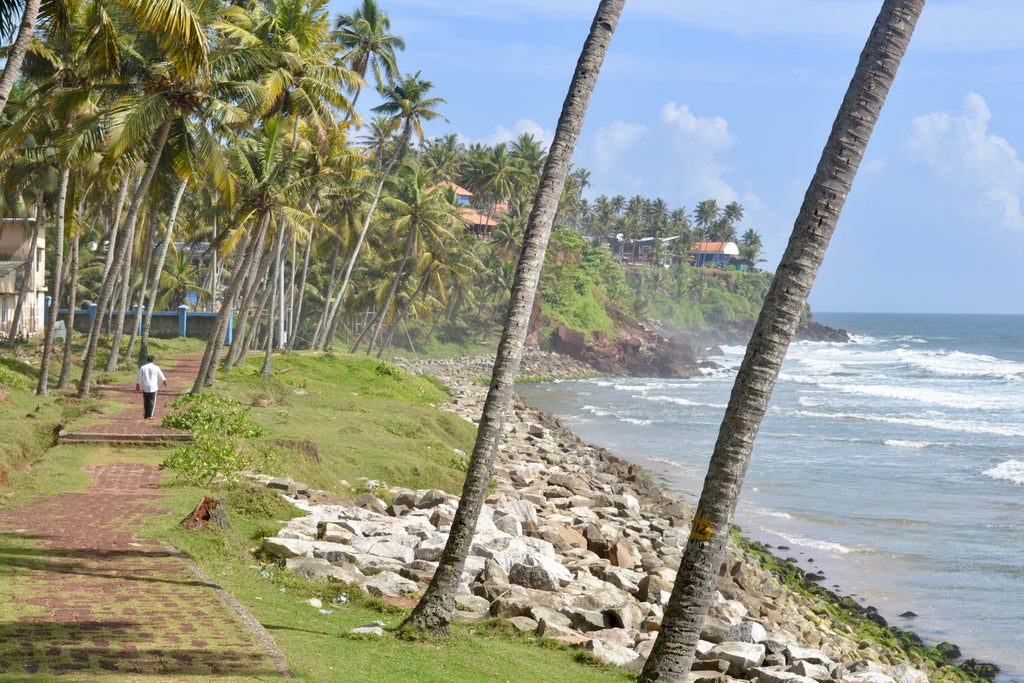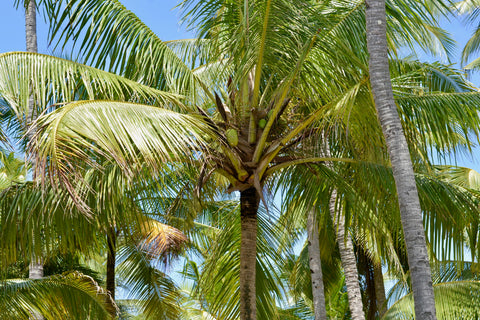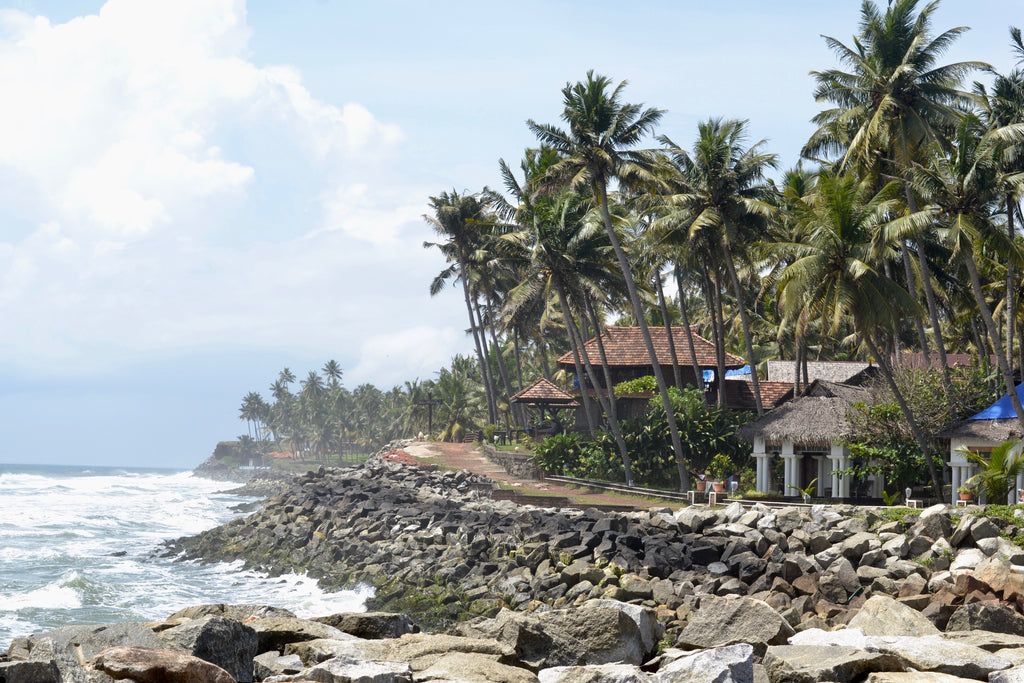The Coconut: Its Uses in Indian Culture and Cuisine
By Conchita de Souza

Not exactly a fruit nor a nut, the coconut sits almost between both classifications but leaning more towards the former than the latter. It is in fact a drupe (a word which sounds like a mythical creature from a Harry Potter novel), a term used to classify stone fruits and under which peaches and nectarines, but also oddly, blackberries and raspberries fall.
For many of us, the sight of coconut trees standing tall against the blue skies is synonymous with tropical travel, white sandy beaches and a mojito (or any beverage of your choice) awaiting us by the shore. For me, it speaks of a home away from home in the land of my ancestors called Goa. This small state is located on India’s west coast, where coconut trees are found in abundance, only to be rivalled in quantity by the southern state of Kerala, which literally means ‘land of the coconuts’.

Skies full of coconut trees in Varkala, south Kerala
In India (and in other countries abounding in coconut), almost every part of the coconut and the coconut tree are used lovingly; the fruit, the nut, the shell and the leaves all serve their purpose. It comes as no surprise that the word for coconut in Sanskrit is kalpavriksha, which means ‘the tree providing the necessities of life’. In terms of its documented history, it dates back as far as 3000 BC and is mentioned in the ancient post-Vedic text called the Mahabharata.
Today, we look at some of the ways coconut has become part and parcel in the lives of Indians.*
Health & Beauty
Indians had used the coconut centuries before the Western world (recently) discovered its benefits. In the south of India, it is not uncommon to see the hair of girls, boys, women and men well-coated with coconut oil, which acts as a natural conditioner. Women from the south are renowned for their thick, dark and luscious locks attributed in some part to genetics, but also to the frequent application of coconut oil from birth.
My mother used to apply coconut oil to my hair in the mornings before I washed it off in the evenings. It is a practice I continue until today, sometimes leaving the oil in overnight for better absorption.
Coconut oil contains moisturising properties which makes it popular for use in hair and skin care products. It can be applied directly to the body like a lotion and contains antiseptic and antibacterial properties. It works well if you suffer from dry skin, especially in the winters (yours truly knows well) and can mend chapped lips too. Now you are probably wondering - ‘Is there anything that this plant can’t do?’
I won’t delve much further into the medicinal uses of coconut, but I will mention a few things. The water of the coconut tastes sweet when it is tender, but also has anti-dehydration properties which replenishes electrolytes far more effectively than your average sports drink. Tender coconut water is high in important minerals like calcium, magnesium (for the heart) and potassium (for the muscles).
Cuisine
"Coconut provides five types of food products: Coconut water, coconut milk, sugar, oil and ‘meat’," or ‘flesh’ as it is also known (Ahuja 2014).
In the south of India, coconut flesh is consumed in a variety of ways - it is ground and made into a chutney, often with the addition of tempered whole spices and used as accompaniments to dosa, idly and vada. In Kerala, Avial is a popular vegetable stew prepared usually with coconut milk that goes well with appam ( a pancake made from fermented rice batter and coconut milk). The Kerala chicken curry also incorporates coconut milk.
In Goa, many curries contain coconut milk at its base, such as Xacuti or Maas Kodi. Even sanas (rice cakes) are prepared using rice flour and coconut milk and they are enjoyed with a sorpotel (spicy pork curry). When vegetables are cooked with minimal spice and a dash of dessicated coconut, it is known as foogath and we have a recipe for pumpkin foogath on our website. Even the sweets of Goa aren’t spared from coconut’s outreach - Bebinc and Dos are two of Goa’s most popular sweets with the former containing coconut milk and the latter, ground coconut. Another favourite tea-time cake and popular during the Christmas season is baath, to which generous amounts of desiccated coconut are added.
The flower clusters of the coconut release a juice, which once fermented, produces a local brew known as toddy or coconut palm wine.
Ceremony
The dry coconut forms an essential element in rituals, ceremonies and festivities amongst Hindus. They are always used in offerings to God and any pooja (prayer) without coconut seems almost incomplete. Coconuts are smashed open whenever there is an initiation into, or inauguration of something new, like the opening of a new building.
In Goa, the groom and bride, in their respective homes, participate in a ceremony called a roce, where they are both blessed by well wishers who, one by one, apply coconut milk to their skin. The idea was that the coconut milk would cleanse the skin of the bride and groom so that they would have a beautiful and clear complexion for their wedding day. Nowadays, the roce has become an event for relatives and friends to douse the bride or groom with coconut milk and have a blast whilst doing so. Click here to see a typical Goan roce in amongst the Catholic community.
Materials
Surprisingly, coconut shells are useful for many things other than from bikini tops delicately strung on the chests of dancing island girls. You may have noticed that the shell of a dried coconut is encased in a husk. This husk produces a fibre called ‘coir’ that is highly resistant to salt water and can be used in the manufacture of ropes, mattresses, brushes and brooms, just to name a few examples. The shells can be treated and used as bowls and utensils, with beautiful carvings engraved into them. Unused shells make good flammable material for an outdoor stove fire.
The palms of the coconut are handy for creating shelter and can be weaved and thatched to create handicrafts like mats or baskets. The bark of the tree is white ant resistant, and therefore is very useful in construction, especially when making rafters.
If you weren’t aware of this amazing plant’s ability to give, I am sure that after reading this, you will have a newfound appreciation for the immense utility that the coconut has offered humanity since the beginning.
*Ahuja, SC (2014) Coconut - History, Uses & Folklore, Asian Agri-History,18(3):221-248 - this was a very helpful resource in putting together this post.

